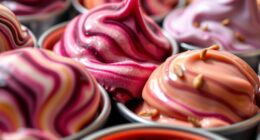If you feel sick after eating ice cream, it could be because of lactose intolerance or the high fat content. Your body might have difficulty digesting the lactose in ice cream, leading to stomach upset and possibly vomiting. The richness of ice cream can exacerbate feelings of nausea, especially when consumed in large quantities. Paying attention to your body’s reactions can help determine if you have lactose intolerance or other digestive problems. By understanding how your body responds to ice cream, you can identify the source of your discomfort. Additional information can provide guidance on managing lactose intolerance or dairy sensitivity for a more pleasant experience.
Key Takeaways
- Ice cream can trigger nausea due to lactose intolerance or high fat content.
- Lactose intolerance can lead to stomach upset, bloating, and vomiting.
- High fat content in ice cream can exacerbate feelings of nausea.
- Recognizing body's response to dairy helps identify lactose intolerance.
- Understanding symptoms helps manage discomfort post ice cream consumption.
Ice Cream and Nausea

If you experience nausea after consuming ice cream, it could be due to factors like lactose intolerance or the high fat content in the dessert.
Ice cream contains lactose, a sugar found in dairy products, which can trigger nausea in individuals who are lactose intolerant. For those with lactose intolerance, the body struggles to break down lactose, leading to symptoms like stomach upset and bloating, often culminating in nausea.
Additionally, the high fat content in ice cream can also play a role in causing feelings of nausea, particularly when consumed in large quantities. This combination of lactose and high fat can be a double whammy for those who are sensitive to these components.
Nausea can be a common symptom experienced by individuals with lactose intolerance after indulging in ice cream, sometimes even resulting in vomiting.
Understanding how your body reacts to ice cream can help determine whether it's lactose intolerance, a dairy allergy, or another underlying issue triggering the nausea. By being mindful of your body's response, you can make informed choices about your dessert options to avoid discomfort.
Body's Reaction to Dairy

The body's response to dairy products like ice cream can vary depending on individual tolerance levels and digestive capacity. Dairy products, including ice cream, contain lactose, a type of sugar that can cause discomfort in some individuals.
If your body lacks enough lactase enzyme to break down lactose effectively, consuming dairy products like ice cream may lead to symptoms such as nausea and vomiting. This is because undigested lactose can ferment in the gut, resulting in gastrointestinal issues.
If you experience nausea after eating ice cream, it could be a sign of lactose intolerance. By understanding how your body reacts to dairy, particularly lactose-containing products like ice cream, you can better manage any discomfort you may feel.
Paying attention to your body's signals and making informed dietary choices can help minimize symptoms like nausea and vomiting associated with consuming dairy products.
Understanding Lactose Intolerance

Understanding lactose intolerance involves recognizing how your body reacts to dairy products containing lactose, such as ice cream. Lactose intolerance occurs when your body lacks the enzyme lactase necessary to digest lactose, a sugar present in dairy products.
When you consume ice cream or other lactose-containing foods, symptoms of lactose intolerance may appear. These symptoms can include nausea, bloating, gas, diarrhea, and vomiting.
It's crucial to be aware that lactose intolerance is a common condition affecting about 70% of adults worldwide. To manage lactose intolerance, you can avoid or limit dairy products like ice cream, consider using lactase enzyme supplements, or incorporate probiotics into your diet to help alleviate symptoms.
Symptoms of Dairy Sensitivity

When consuming ice cream, recognizing symptoms of dairy sensitivity, such as nausea and vomiting, is essential for understanding your body's reaction. Dairy sensitivity or food allergy can manifest through various symptoms, impacting your digestive system. Apart from nausea and vomiting, individuals with dairy sensitivity may experience abdominal cramping, gas, and bloating after consuming ice cream due to the body's inability to properly digest lactose. This inflammatory response in the digestive system can lead to discomfort and feelings of nausea.
To help you identify if dairy sensitivity is the culprit behind your symptoms, here is a breakdown of common signs to look out for:
| Symptom | Description |
|---|---|
| Nausea | Feeling of illness in the stomach |
| Vomiting | Forceful expulsion of stomach contents |
| Abdominal Cramping | Sharp pain or discomfort in the abdomen |
| Gas | Excess air in the digestive tract causing discomfort |
| Bloating | Feeling of fullness or swelling in the abdomen |
Understanding these symptoms can assist you in determining if dairy sensitivity is causing your discomfort after consuming ice cream.
Reasons for Vomiting

If you find yourself vomiting after consuming ice cream, it could be a sign of lactose intolerance or a sensitivity to dairy ingredients. Ice cream contains dairy, which can trigger vomiting in individuals with lactose intolerance or a dairy allergy.
The body's inability to break down lactose in ice cream can lead to symptoms like nausea and vomiting, especially if you have lactose intolerance. Vomiting after consuming ice cream may indicate a sensitivity to the ingredients in the ice cream, such as milk proteins or additives.
If you consistently feel like throwing up after eating ice cream, consulting a healthcare provider is crucial to determine the underlying cause and explore potential solutions.
- Lactose intolerance can cause vomiting after consuming ice cream.
- Dairy ingredients in ice cream may trigger vomiting in individuals with dairy allergies.
- Inability to break down lactose in ice cream can lead to nausea and vomiting.
- Sensitivity to milk proteins or additives in ice cream can result in vomiting.
- Seeking advice from a healthcare provider is essential if you experience persistent vomiting after eating ice cream.
Ice Cream and Digestive Distress

If you've ever felt sick after enjoying a scoop of ice cream, lactose could be the culprit.
Lactose in ice cream can trigger digestive issues like bloating, gas, and diarrhea in those with lactose intolerance.
Understanding how your body reacts to ice cream can help you make informed choices to prevent discomfort.
Ice Cream Digestion
Ice cream can trigger digestive distress in some individuals due to lactose intolerance, a condition where the body struggles to fully digest lactose found in dairy products like ice cream.
If you experience symptoms like nausea, bloating, gas, abdominal cramping, or diarrhea after consuming ice cream, it could be due to lactose intolerance.
Here are some key points to keep in mind:
- Lactose intolerance leads to difficulty digesting ice cream, causing unpleasant symptoms.
- Symptoms may include nausea, bloating, gas, abdominal cramping, and diarrhea.
- The high fat content in ice cream can worsen digestive discomfort.
- Consuming dairy products with lactose can result in upset stomach and vomiting.
- Managing symptoms involves avoiding dairy or using lactase enzyme supplements.
Understanding how your body reacts to ice cream and dairy products can help you make informed choices to prevent digestive distress.
If you suspect lactose intolerance, consulting a healthcare provider for proper diagnosis and guidance is advisable.
Vomiting After Ice Cream
Experiencing vomiting after consuming ice cream can indicate potential lactose intolerance, a condition where the body struggles to digest lactose present in dairy products. The high lactose content in ice cream can trigger symptoms like nausea and vomiting in individuals with lactose intolerance. When the body cannot break down lactose, it can lead to digestive distress, causing the undigested lactose to sit in the digestive system and potentially result in vomiting. The severity of symptoms post ice cream consumption varies based on the individual's lactase enzyme production levels.
To help you understand the connection between vomiting after ice cream and lactose intolerance, let's break it down in a simple table:
| Symptom | Cause | Recommendation |
|---|---|---|
| Vomiting | Lactose intolerance | Consult healthcare provider |
| Nausea | High lactose content | Consider lactose-free alternatives |
| Digestive discomfort | Undigested lactose | Monitor dairy intake |
Nausea and Ice Cream
When experiencing nausea after consuming ice cream, it may be a sign of potential lactose intolerance, a common digestive issue.
Ice cream contains lactose, a sugar found in dairy products that can trigger digestive distress, leading to symptoms like nausea, bloating, and gas.
If you find yourself feeling queasy after indulging in ice cream, it's possible that your body is struggling to digest the lactose present in it.
Understanding how your body reacts to ice cream can help you identify and manage potential lactose intolerance more effectively.
Here are some key points to keep in mind:
- Ice cream contains lactose, a sugar that can cause digestive discomfort in lactose-intolerant individuals.
- Nausea after consuming ice cream could indicate an inability to properly digest lactose.
- Bloating and gas following ice cream consumption are common symptoms of lactose intolerance.
- Recognizing your body's response to ice cream can aid in pinpointing potential lactose intolerance.
- Managing lactose intolerance involves adjusting your diet to minimize symptoms when consuming ice cream.
Lactose Intolerance Triggers

If you consume dairy products like ice cream and feel nauseous afterwards, it may be a sign of lactose intolerance triggers. Ice cream contains lactose, a sugar found in milk, which can lead to symptoms of lactose intolerance like nausea.
Lactose intolerance is a common condition where the body lacks the enzyme lactase required to break down lactose in dairy products such as ice cream. After consuming ice cream, individuals with lactose intolerance may experience gastrointestinal discomfort, including nausea and vomiting.
The severity of symptoms like nausea can vary based on individual tolerance levels and the amount of lactose ingested. Feeling like throwing up after eating ice cream might indicate lactose intolerance.
Managing these symptoms can involve avoiding dairy products or utilizing lactase supplements to aid in lactose digestion. Understanding these triggers can help you make informed choices about your diet to prevent discomfort and promote better digestive health.
Coping With Dairy Reactions

Coping with dairy reactions, such as feeling nauseous after consuming ice cream, involves understanding how lactose intolerance affects your body's ability to digest dairy products.
When dealing with dairy reactions like nausea from ice cream, consider the following strategies:
- Avoiding Dairy Products: Steering clear of ice cream and other dairy items can help prevent unpleasant symptoms associated with lactose intolerance.
- Using Lactase Supplements: Taking lactase enzymes before consuming dairy products like ice cream can aid in the digestion of lactose.
- Trying Dairy-Free Alternatives: Opting for dairy-free ice cream options made from almond, coconut, or soy milk can be a tasty way to sidestep dairy reactions.
- Monitoring Symptoms: Keeping track of how your body reacts to different dairy products, like ice cream, can help pinpoint specific triggers.
- Seeking Professional Advice: Consulting a healthcare provider can provide insights into whether your symptoms post ice cream consumption are linked to lactose intolerance or another underlying issue like a dairy allergy.
Navigating Food Sensitivities

Understanding and managing food sensitivities involves recognizing how your body responds to different foods. If you experience nausea after eating ice cream, it could be due to a common food sensitivity known as lactose intolerance. Ice cream contains lactose, a sugar found in dairy products, which can trigger digestive issues in individuals sensitive to it.
To navigate food sensitivities like lactose intolerance, paying close attention to your body's reactions and keeping a food diary to track symptoms after consuming certain foods is crucial. This can help pinpoint the root cause of your discomfort and identify potential triggers.
Consulting a healthcare professional or a registered dietitian can also provide personalized guidance on managing food sensitivities, including lactose intolerance. By understanding how your body responds to different foods and seeking professional advice, you can effectively navigate and address food sensitivities for better digestive health.
Managing Digestive Discomfort

Managing digestive discomfort involves implementing strategies to alleviate symptoms and improve your overall well-being. If you experience digestive issues like nausea, bloating, or diarrhea after eating ice cream due to lactose intolerance, there are steps you can take to manage these symptoms effectively.
Here are some tips to help you navigate digestive discomfort:
- Avoid lactose-containing foods: Steering clear of dairy products or opting for lactose-free alternatives can help prevent digestive issues.
- Use lactase enzyme supplements: Taking lactase enzyme tablets before consuming dairy can aid in the breakdown of lactose, reducing symptoms.
- Incorporate probiotics: Foods rich in probiotics, such as yogurt or kefir, can promote gut health and ease digestive discomfort in some individuals.
- Listen to your body: Pay attention to how different foods affect your digestion and make informed choices based on your body's responses.
- Consult a healthcare provider: If you continue to experience severe digestive issues, seek guidance from a healthcare professional to develop a personalized management plan.
Frequently Asked Questions
Why Do I Feel Like Throwing up After Eating Ice Cream?
You feel like throwing up after eating ice cream because your body might be lactose intolerant. The lactose in ice cream can be hard for your system to digest, causing nausea. Recognizing this can lead to dietary changes for comfort.
Why Does Eating Cream Make Me Feel Sick?
Eating cream may make you feel sick because of lactose intolerance. Your body struggles to digest lactose in cream, leading to discomfort like nausea. Understanding this reaction can help you avoid feeling unwell after consuming dairy.
Why Does Ice Cream Make Me Feel Weird?
Eating ice cream might make you feel weird because of lactose intolerance. Your body struggles to digest lactose in ice cream, causing symptoms like nausea and vomiting. Consider consulting a healthcare provider for guidance.
Why Am I so Sensitive to Ice Cream?
Feeling like ice cream's your arch-nemesis? Your sensitivity might be due to lactose intolerance. Your body rebels against that dairy sugar, causing nausea and a not-so-fun time. Consider alternatives or lactase supplements.
Is Feeling Like Throwing Up When Eating Ice Cream Related to Coughing After Consuming It?
Some people may experience a strange “understanding ice cream cough reaction” which involves feeling like throwing up when eating ice cream and then coughing after consuming it. This could be related to an intolerance to dairy, sensitivity to cold foods, or an overactive gag reflex. It’s best to consult a doctor for proper diagnosis.
Conclusion
Next time you feel like tossing your cookies after indulging in some creamy ice cream, remember that your body is simply trying to tell you something. Listen to what it's saying and take care of yourself.
Understanding your body's reactions to dairy products can help you navigate food sensitivities and manage digestive discomfort.
So, take a moment to reflect on what your body needs and make choices that will leave you feeling happy and healthy.
















